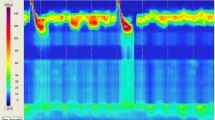Abstract
Background
Peroral endoscopic myotomy (POEM) was introduced as a new effective therapeutic option for esophageal achalasia.
Method
A total of 112 achalasia patients categorized into three subtypes by HRM who underwent POEM were enrolled in our study. Eckardt score and HRM were performed preoperation, 6 months, and 1 year after POEM to evaluate the effectiveness, safety, and feasibility of POEM and to investigate the treatment response to POEM for the three subtypes of achalasia, classified by high-resolution manometry (HRM).
Results
POEM was successfully performed in all patients. Compared with pre-POEM scores, the Eckardt scores were significantly reduced from 7.3 ± 1.4 to 1.0 ± 0.8 6 months after POEM and to 1.2 ± 0.6 1 year after POEM (p < 0.05). The LESP before treatment was 41.8 ± 15.3 mmHg, compared with a LESP of 18.4 ± 7.1 mmHg 6 months after POEM and 20.7 ± 7.5 mmHg 1 year after POEM (p < 0.05). In addition, POEM decreased the 4-s IRP from 33.4 ± 9.0 to 14.6 ± 3.8 mmHg 6 months after POEM and to 16.4 ± 3.9 mmHg 1 year after POEM (p < 0.05). The 4-s IRP was reduced to <15 mmHg in 64 of 112 patients. Type II had the best response to POEM, while type III exhibited the worst response.
Conclusions
POEM appears to be an effective and less invasive treatment for achalasia. HRM can be useful in the classification of achalasia, while these subclassifications help to predict the responsiveness to POEM.


Similar content being viewed by others
References
Podas T, Eaden J, Mayberry M, Mayberry J (1998) Achalasia: a critical review of epidemiological studies. Am J Gastroenterol 93:2345–2347
Cheng YS, Li MH, Chen WX, Chen NW, Zhuang QX, Shang KZ (2003) Selection and evaluation of three interventional procedures for achalasia based on long-term follow-up. World J Gastroenterol 9:2370–2373
Tsiaoussis J, Athanasakis E, Pechlivanides G, Tzortzinis A, Gouvas N, Mantides A et al (2007) Long-term functional results after laparoscopic surgery for esophageal achalasia. Am J Surg 193:26–31
Inoue H, Minami H, Kobayashi Y, Sato Y, Kaga M, Suzuki M et al (2010) Peroral endoscopic myotomy (POEM) for esophageal achalasia. Endoscopy 42:265–271
Eckardt VF (2001) Clinical presentations and complications of achalasia. Gastrointest Endosc Clin N Am 11:281–292
Jones R, Junghard O, Dent J, Vakil N, Halling K, Wernersson B et al (2009) Development of the GerdQ, a tool for the diagnosis and management of gastro-oesophageal reflux disease in primary care. Aliment Pharmacol Ther 30:1030–1038
Allaix ME, Patti MG (2013) New trends and concepts in diagnosis and treatment of achalasia]. Cir Esp 91:352–357
Bredenoord AJ, Hebbard GS (2012) Technical aspects of clinical high-resolution manometry studies. Neurogastroenterol Motil 24(Suppl. 1):5–10
Roman S, Kahrilas PJ, Boris L, Bidari K, Luger D, Pandolfino JE (2011) High-resolution manometry studies are frequently imperfect but usually still interpretable. Clin Gastroenterol Hepatol 9:1050–1055
Pandolfino JE, Kwiatek MA, Nealis T, Bulsiewicz W, Post J, Kahrilas PJ (2008) Achalasia: a new clinically relevant classification by high-resolution manometry. Gastroenterology 135:1526–1533
Eleftheriadis N, Inoue H, Ikeda H, Onimaru M, Yoshida A, Hosoya T et al (2012) Training in peroral endoscopic myotomy (POEM) for esophageal achalasia. Ther Clin Risk Manag 8:329–342
Beck WC, Sharp KW (2011) Achalasia. Surg Clin North Am 91:1031–1037
Vaezi MF, Pandolfino JE, Vela MF (2013) ACG clinical guideline: diagnosis and management of achalasia. Am J Gastroenterol 108:1238–1249 quiz 50
Patti MG, Arcerito M, De Pinto M, Feo CV, Tong J, Gantert W et al (1998) Comparison of thoracoscopic and laparoscopic Heller myotomy for achalasia. J Gastrointest Surg 2:561–566
Allaix ME, Patti MG (2013) What is the best primary therapy for achalasia: medical or surgical treatment? Who owns achalasia? J Gastrointest Surg 17:1547–1549
Boeckxstaens G, Zaninotto G (2012) Achalasia and esophago-gastric junction outflow obstruction: focus on the subtypes. Neurogastroenterol Motil 24(Suppl 1):27–31
Pescarus R, Shlomovitz E, Swanstrom LL (2014) Per-oral endoscopic myotomy (POEM) for esophageal achalasia. Current Gastroenterol Rep 16:369
Hungness ES, Teitelbaum EN, Santos BF, Arafat FO, Pandolfino JE, Kahrilas PJ et al (2013) Comparison of perioperative outcomes between peroral esophageal myotomy (POEM) and laparoscopic Heller myotomy. J Gastrointest Surg 17:228–235
Swanstrom LL, Kurian A, Dunst CM, Sharata A, Bhayani N, Rieder E (2012) Long-term outcomes of an endoscopic myotomy for achalasia: the POEM procedure. Ann Surg 256:659–667
Kwiatek MA, Pandolfino JE, Hirano I, Kahrilas PJ (2010) Esophagogastric junction distensibility assessed with an endoscopic functional luminal imaging probe (EndoFLIP). Gastrointest Endosc 72:272–278
Disclosures
Drs. Hui Ju, Yongfen Ma, Kun Liang, Cuiping Zhang, and Zibin Tian have no conflicts of interest or financial ties to disclose.
Author information
Authors and Affiliations
Corresponding author
Additional information
Hui Ju and Yongfen Ma have contributed equally to this work.
Rights and permissions
About this article
Cite this article
Ju, H., Ma, Y., Liang, K. et al. Function of high-resolution manometry in the analysis of peroral endoscopic myotomy for achalasia. Surg Endosc 30, 1094–1099 (2016). https://doi.org/10.1007/s00464-015-4304-9
Received:
Accepted:
Published:
Issue Date:
DOI: https://doi.org/10.1007/s00464-015-4304-9




